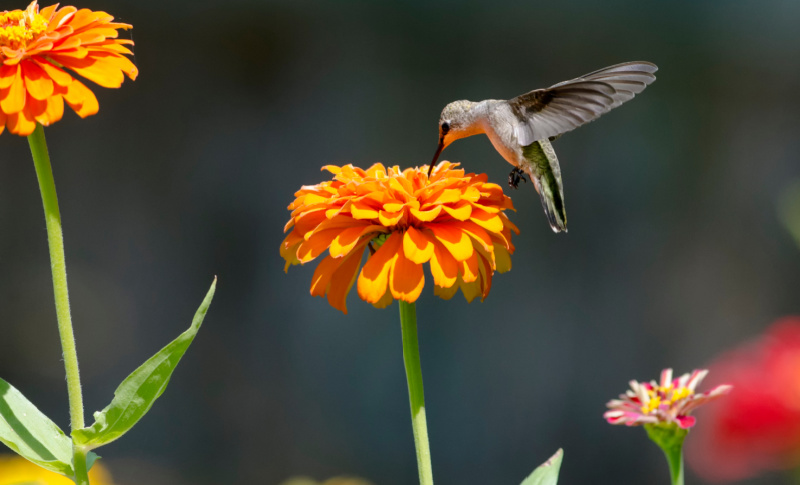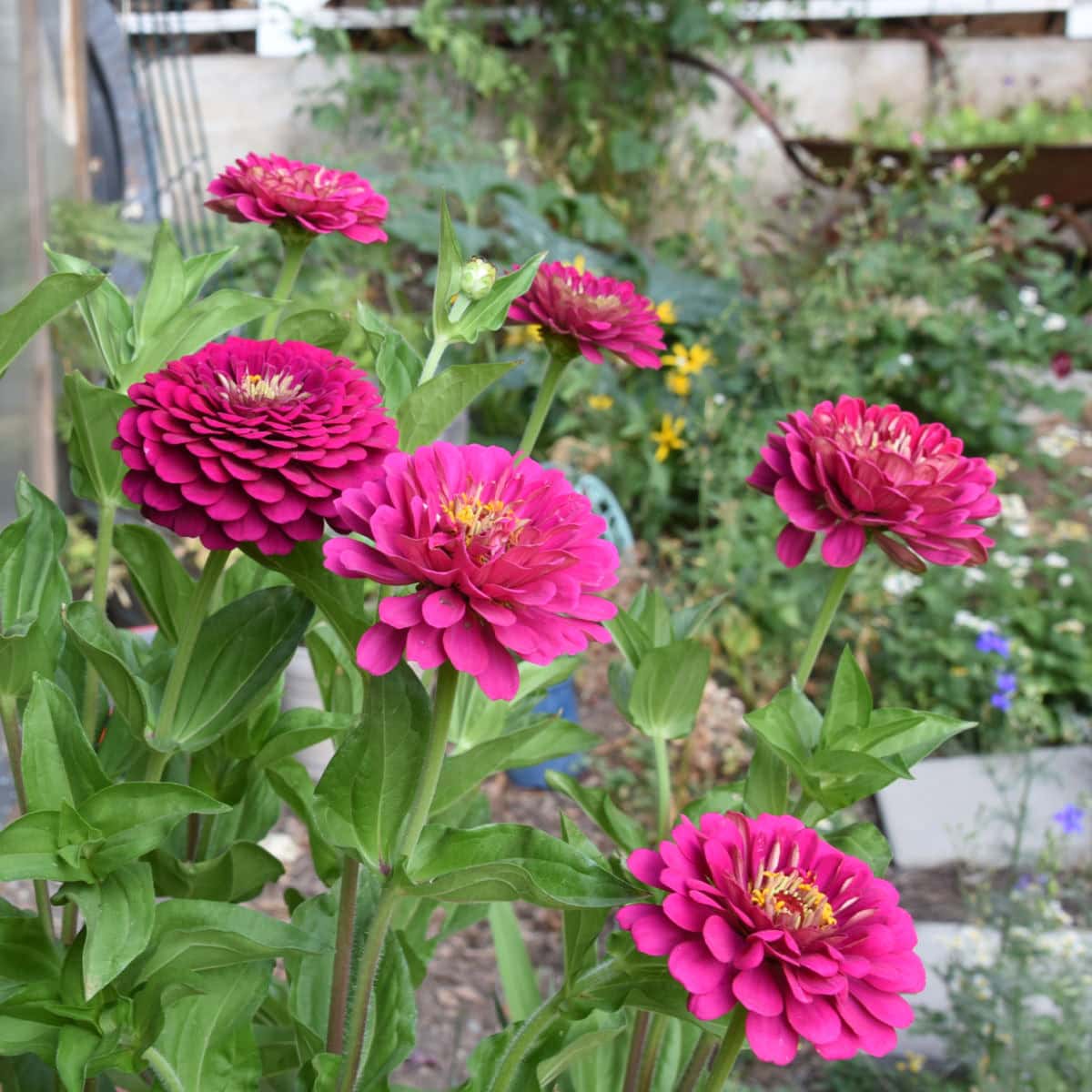A Beginners Guide to Growing Beautiful Zinnias from Seed
Follow along to discover how easy it is to grow Zinnias from seed! I have grown zinnias for 30-plus years and they never fail to add sensational color to the garden for very little money.
Hey Garden Friends, if you’re aiming to fill your garden with beautiful flowers that are easy to grow, zinnia flowers should top your list. These annual blooms bring a beautiful burst of color to garden beds, containers and anywhere you can fit them in the landscape.
They also make great cut flowers for indoor enjoyment. Beginners gardeners can master growing zinnias from seed right out of the gate.

This post contains affiliate links. If you make a purchase after clicking a link I may make a small commission at no cost to you.
Here are all the steps I use to cultivate young zinnia plants from seed, ensuring vibrant zinnia blooms from early Summer until the first frost, year after year.
Many of the zinnia varieties you will encounter belong to the species Zinnia elegans classification but there are also Mexican Zinnias (Z. haageana) and Zahara zinnias (Z. marylandica). All are annual flowers.
Why Choose Zinnias?
Zinnias are annual plants, completing their life cycle in one year, making them ideal for gardeners who enjoy experimenting with new seeds or colors each season. They are some of the easiest flowers to grow from seed and are renowned for making beautiful cut flowers. Additionally, they attract droves of pollinators such as bees, butterflies, and hummingbirds.

Being so easy to grow they are a wonderful gateway flower for newbie gardeners and low cost for the budget-minded.
Related: Did you know there is a big benefit to growing zinnias in your vegetable garden?
Selecting Your Seeds
Decide how you wish to use the zinnias. Along a pathway, as a filler flower, or in your cut flower garden. Some grow in a more mounding shape while others are straight and tall.
Whether shopping at your local garden center or online, look for zinnia seed packets that specify tall zinnias with strong stems, ideal for cutting, or opt for bushier plants that enhance the front of a flower border. The wide range of types and sizes makes fitting them in any garden design easier.

Open-pollinated varieties of zinnias can offer unique flower heads and allow you to save seeds for planting the following year. If you are fortunate they may reseed themselves, though I have yet to experience that.
Planting Your Zinnias
Best Time to Sow
The best time to plant zinnias is, after the danger of frost, when the soil has warmed up to about 70 degrees.
In early spring you can start your seeds indoors about 4-6 weeks before the last frost date. Mine have germinated in a few days when I use a heat mat.
In cooler climates starting indoors will give you a head start on blooms and in warmer climates, it is easier to direct sow. But it is very important that the soil temperature is above 65 and the day and night temperatures are steadily warm when seeding zinnias. (never below 55 degrees)
It does not matter what your garden zone is, that is not what determines your first and last frost date or your local temperatures.
Soil Preparation
Zinnias thrive in moist soil that drains well. Enrich your garden beds with compost to improve soil moisture retention and structure. For the best results, choose a site where your zinnias will receive full sun.
Most plants do better in well-drained soil. If your soil is junk then hop on over here to find out how you can improve it with organic matter.
All the best garden tips
Build the Best Soil!
Building your organic garden soil is essential for long-term gardening success. Here you will learn the best tricks for great garden soil. Beginner gardener friendly!
More on what fertilizer you can use further down to help until you can build your soil health.
Sowing the Seeds
Plant your zinnia seeds about a quarter-inch deep directly into the prepared soil. If you’re planting taller varieties, ensure adequate space between seeds to give each plant room to develop strong stems.
This also allows for good air circulation which is key to preventing diseases. Water gently at the base of the plants to maintain soil moisture without wetting the foliage, which can lead to fungal diseases.
Read the seed packet for exact directions on different zinnia varieties.
Germination and Thinning
Zinnia seedlings usually appear within 7-10 days. Once they have a few sets of leaves, thin them so that there is 6-18 inches between each plant, depending on the variety.
This spacing helps promote air circulation and reduces the risk of diseases. I hate to waste seeds so I usually plant them far enough apart when I seed them.
And now that I start many indoors I put one in each pot or cell of a six-pack tray and then when they are ready to transplant, I give them the proper spacing. (see the section below for more)
Lazy Gal Gardening Way: I admit I have just broadcast seeds into a bed and let them come up as they please, which worked too. If they are closer together when planted this way the flowers may be smaller and they may get powdery mildew. But the ease made it all worth while.
Planting Zinnia Seedlings
This pertains to those who chose to start seeds indoors. You need to harden off the seedlings before planting them out in the garden.
This must be done or you risk losing all of your seedlings. Read here how you can do it safely and easily.
How to Harden Off Seedlings
Simple yet effective.
When planting out your zinnia seedlings it is just as important for the soil to be warm and the weather to be settled with no threat of frost or a deep dip in temperatures. Zinnias like it warm, very warm, and will shrivel up in cold temperatures.
Gently remove the seedlings from their container, careful to cause minimal disturbance to the roots. Plant in your garden beds at the same depth they grew in the starter pots.
Do not add amendments or starter fertilizers in the planting hole! After placing the zinnia seedling into the hole, replace the native soil around the base and firm it in gently.
Water well and add a layer of compost or organic mulch to retain moisture. Step back and let them grow!
Caring for Zinnias from Seed
Watering:
It’s important to water zinnias at the base of the plants to avoid wet leaves and prevent mildew. They typically need about an inch of water per week.
Fertilizing:
A balanced, slow-release fertilizer at the time of planting can encourage lush growth and abundant blooms. Another feeding might be necessary mid-season if the plants appear sluggish. (for proper application see Soil Amendments)
I use compost as a slow release as I have healthy, nutrient-rich soil and if you have healthy soil it saves you money on fertilizers. If I find that my plants need a boost I give them a liquid feed that feeds the soil and the plants.
This is made entirely from food waste and is perfect for the regenerative, organic gardener!
Deadheading:
To encourage more zinnia blooms and extend the flowering period, remove faded or spent flower heads regularly.

Disease and Pest Management:
Keep an eye out for signs of powdery mildew, especially in damp or humid weather. Proper plant spacing and air circulation help minimize this risk.
If Japanese beetles pose a threat, pick them off the plants early in the morning. Japanese Beetles are known to love Zinnias and will kill young plants overnight. If you have difficulties with Japanese Beetles plant Zonal geraniums nearby. When they eat on the geraniums it makes them comatose then it is easy for you to collect and dispose of them.
for a more in-depth post see here
10 Tips for Growing Zinnias with Success!
Enjoying and Preserving Your Zinnias
Zinnias make beautiful cut flowers. Cut them early in the morning and immediately place them in water to ensure they last longer. For those interested in preserving their beautiful zinnia flowers, they can be dried by hanging them upside down in a dry place, making them perfect for crafts or dried arrangements.
By planting new seeds each year and caring for your zinnias throughout the growing season, you can ensure that these annual flowers bring joy and color to your garden beds each year. With minimal effort, zinnias can provide continuous beauty and enjoyment both outdoors and as part of indoor floral arrangements.
Happy Zinnia Gardening!





